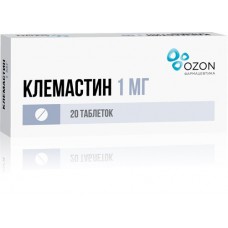Expiration date: 02/2026
Release form
Tablets, 1 mg - 20 pcs per pack.
Composition per 1 tablet:
Active substance: clemastine fumarate -1.34 mg (in terms of clemastine -1.00 mg).
Excipients: lactose monohydrate (milk sugar) - 107.66 mg; corn starch - 10.80 mg; talc - 5.00 mg; povidone-K25 - 4.00 mg; magnesium stearate - 1.20 mg.
Pharmacotherapeutic group
antiallergic agent - H1-histamine receptor blocker
Pharmacodynamics
H1-histamine receptor blocker, belongs to the antihistamines of the group of benzhydryl esters. It has a strong antihistamine and antipruritic effect with a rapid onset of action and a duration of up to 12 hours, prevents the development of vasodilation and contraction of smooth muscles induced by histamine.
Having an antiallergic effect, it reduces the permeability of blood vessels, capillaries, inhibits exudation and the formation of edema, reduces itching, has an m-holinoblocking effect.
Pharmacokinetics
Suction
After oral administration, clemastine is almost completely absorbed from the gastrointestinal tract. The maximum concentrations in blood plasma are reached after 2-4 hours . The antihistamine effect of the drug reaches a maximum after 5-7 hours; as a rule, the effect lasts up to 10-12 hours, in some cases up to 24 hours.
Distribution
The binding of clemastine to plasma proteins is 95%.
Metabolism
Clemastine undergoes significant metabolism in the liver.
Withdrawal
Plasma excretion is of a two-phase nature, the corresponding half-lives are 3.6 ± 0.9 h and 37 ± 16 h. Metabolites are mainly (45-65%) excreted by the kidneys; unchanged active substance is found in urine only in trace amounts.
During breastfeeding, a small amount of clemastine may enter breast milk.
Indications
- Pollinosis (hay fever, including allergic rhinoconjunctivitis);
- urticaria of various origins;
- itching, itchy dermatoses;
- acute and chronic eczema, contact dermatitis as auxiliary therapy;
- drug allergy as an auxiliary therapy;
- insect bites.
Contraindications
- Hypersensitivity to clemastine or other components of the drug, as well as to similar antihistamines;
- pregnancy;
- breastfeeding period;
- taking monoamine oxidase inhibitors (MAO);
- diseases of the lower respiratory tract (including bronchial asthma);
- porphyria;
- children under 6 years of age (for this dosage form);
- lactase deficiency, lactose intolerance, glucose-galactose malabsorption;
- elderly patients.
With caution:
You should consult a doctor if you have one of the following diseases/states:
- Epilepsy or seizures in the anamnesis;
- Stenosing stomach ulcer;
- Pyloroduodenal obstruction;
- Obstruction of the bladder neck;
- Prostatic hyperplasia, accompanied by urinary retention;
- Increased intraocular pressure;
- Angle-closure glaucoma;
- Hyperthyroidism;
- Diseases of the cardiovascular system, including hypertension.
Use during pregnancy and during breastfeeding:
Pregnancy
There are no sufficient data on the use of clemastine in pregnant women. The use of the drug is contraindicated in pregnant women.
Breastfeeding period
Antihistamines can be excreted in breast milk and have an effect on the baby. Clemastine is contraindicated in nursing women.
Fertility:
There are no clinical data on the effect of clemastine on fertility in men and women.
Available preclinical data have revealed a potential adverse effect on male fertility at a dose exceeding the clinical dose for oral administration in humans.
Method of administration and dosage
For oral administration.
Do not exceed the recommended dose!
The drug is administered orally before meals, washed down with water.
Adults and children over 12 years of age: 1 tablet (1 mg) in the morning and evening. According to the doctor's recommendation, the daily dose can be up to 6 tablets. The maximum single dose should not exceed 2 tablets at a time.
Children aged 6 to 12 years: by ? - 1 tablet in the morning and evening.
Side effects
The following adverse reactions were detected spontaneously during post-registration use of the drug. Adverse reactions are classified by body systems and according to the frequency of development. The frequency of adverse reactions is determined as follows: very often (?1/10); often (?1/100, <1/10); infrequently (?1/1000, <1/100); rarely (?1/10 000, <1/1000); very rare (<1/10 000), frequency unknown (frequency cannot be estimated based on available data).
Disorders of the nervous system
Often: increased fatigue, drowsiness, sedation, weakness, fatigue, lethargy, impaired coordination of movements;
Infrequently: dizziness;
Rarely: headache, tremor, stimulating effect (usually in children): anxiety, increased irritability, agitation, nervousness, insomnia, hysteria, euphoria, tremor, convulsions; paresthesia, neuritis.
Disorders of the gastrointestinal tract
Rarely: dyspepsia, nausea, vomiting, gastralgia, dry mouth;
Very rare: constipation.
Isolated cases of decreased appetite and diarrhea.
Visual organ disorders
Rarely: impaired visual clarity, diplopia.
Hearing disorders and labyrinthine disorders
Rarely: acute labyrinthitis, tinnitus.
Disorders of the kidneys and urinary tract
Very rarely: frequent or difficult urination.
Disorders of the respiratory system, chest and mediastinal organs
Rarely: thickening of bronchial secretions and difficulty in the discharge of sputum, a feeling of pressure in the chest, respiratory failure, nasal congestion.
Disorders of the cardiovascular system
Rarely: decreased blood pressure (more often in elderly patients), extrasystole.
Very rare: tachycardia.
Disorders of the blood and lymphatic system
Rarely: hemolytic anemia, thrombocytopenia, agranulocytosis.
Disorders of the skin and subcutaneous tissues
Rare: skin rash.
Disorders of the immune system
Rarely: hypersensitivity reactions (rash, shortness of breath, anaphylactic shock).
If any of the side effects listed in the instructions worsen, or you notice any other side effects not listed in the instructions, inform your doctor.
Overdose
Symptoms. Overdose of antihistamines can lead to both depressing and stimulating effects on the central nervous system, the latter is more often observed in children, for example, a decrease in consciousness, excitability, hallucinations or seizures. Anticholinergic effects may also develop: dry mouth, fixed dilation of the pupils, "flushes" of blood to the upper half of the body, disorders of the gastrointestinal tract (nausea, epigastric pain, vomiting), tachycardia.
Treatment. Treatment consists of symptomatic therapy and compliance with the recommendations of specialized medical institutions. If the patient does not vomit spontaneously, then it should be induced artificially (only if the patient's consciousness is preserved). If 3 hours or a little more have passed since taking the drug, it is necessary to perform gastric lavage using 0.9% sodium chloride solution and activated charcoal. You can also prescribe a saline laxative.
Drug interaction
The drug enhances the effect of drugs that depress the central nervous system (hypnotics, sedatives, anxiolytics, antidepressants, opioid analgesics), m-cholinoblockers, as well as alcohol.
Incompatible with simultaneous administration of MAO inhibitors.
Since clemastine has anticholinergic activity, the effect of some anticholinergic drugs (for example, atropine, tricyclic antidepressants) may increase.
Special instructions
The drug contains lactose monohydrate. Patients with rare hereditary disorders of lactose intolerance, general lactase deficiency or glucose-galactose malabsorption are contraindicated to use this drug. To prevent distortion of the results of skin scarification tests for allergens, the drug must be canceled 72 hours before the allergological testing.
Influence on the ability to drive vehicles and other mechanisms:
Clemastine has a slight sedative effect (from mild to moderate in intensity), therefore, persons taking the drug Clemastine are advised to refrain from driving vehicles, working with mechanisms, as well as from other activities that require increased concentration and speed of psychomotor reactions.
Storage temperature
from 2℃ to 25℃


